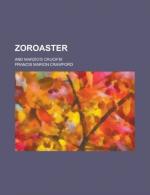“It is well,” answered Zoroaster. “Go thou, and feast with the rest.”
The man saluted, and left the room. Zoroaster remained standing alone, his teeth chattering together and his strong limbs shaking beneath him. But he abandoned himself to no frenzy of grief, nor weeping; one seeing him would have said he was sick of a fever. His blue eyes stared hard at the lamp-light and his face was white, but he did not so much as utter an exclamation, nor give one groan. He went and sat down upon a chair and folded his hands together, as though waiting for some event. But nothing happened; no one came to disturb him in his solitude, though he could hear the tramping feet and the unceasing talk of the slaves and soldiers without. In the vast palace, where thousands dwelt, where all were feasting or talking of the coming banquet, Zoroaster was utterly alone.
At last he rose, slowly, as though with an effort, and paced twice from one end of the room to the other. Upon a low shelf on one side, his garments were folded together, while his burnished cuirass and helmet and other arms which he had not worn upon his rapid journey to Ecbatana, hung upon nails in the wall above. He looked at all these things and turned the clothes over piece by piece, till he had found a great dark mantle and a black hood such as was worn in Media. These he put on, and beneath the cloak he girded a broad, sharp knife about him. Then wrapping himself closely round with the dark-coloured stuff and drawing the hood over his eyes, he lifted the curtain of his door and went out, without casting a look behind him.
In the crowd of slaves he passed unnoticed; for the hall was but dimly lighted by a few torches, and every one’s attention was upon the doings of the day and the coming feast.
Zoroaster soon gathered from the words he heard spoken, that the banquet had not yet begun, and he hastened to the columned porch through which the royal party must pass on the way to the great hall which formed the centre of the main building. Files of spearmen, in their bronze breastplates and scarlet and blue mantles, lined the way, which was strewn with yellow sand and myrtle leaves and roses. At every pillar stood a huge bronze candlestick, in which a torch of wax and fir-gum burned, and flared, and sent up a cloud of half pungent, half aromatic smoke. Throngs of slaves and soldiers pressed close behind the lines of spearmen, elbowing each other with loud jests and surly complaints, to get a better place, a sea of moving, shouting, gesticulating humanity. Zoroaster’s great height and broad shoulders enabled him easily to push to the front, and he stood there, disguised and unknown, peering between the heads of two of his own soldiers to obtain the first view of the procession as it came down the broad staircase at the end of the porch.
Suddenly the blast of deep-toned trumpets was heard in the distance, and silence fell upon the great multitude. With a rhythmic sway of warlike tone the clangour rose and fell, and rose again as the trumpeters came out upon the great staircase and began to descend. After them came other musicians, whose softer instruments began to be heard in harmony with the resounding bass of the horns, and then, behind them, came singers, whose strong, high voices completed the full burst of music that went before the king.




